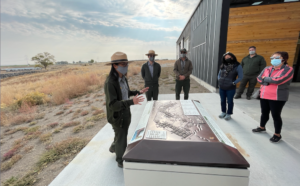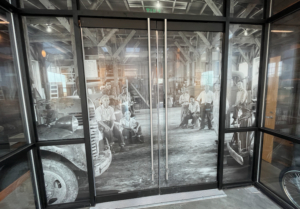Lava Ridge Wind Project: An important project with important issues
Idaho's first major wind project on public land could be among the largest in the West and play an essential role in the necessary transition away from fossil fuels. However, the impacts of such a large project must be adequately assessed, and appropriate alternatives must be considered.ICL supports well-thought out renewable energy projects. We believe that renewable energy is critical in addressing our climate crisis and will help lead Idaho and the Western U.S. on a path toward a clean energy future -- as well as in addressing social justice issues where communities are directly affected by fossil fuel pollution. As proposed, the Lava Ridge Wind project near Dietrich would involve up to 400 wind turbines between 390 and 740 feet tall, placing them among the tallest man-made structures in Idaho. While this level of scale is necessary to replace fossil fuels, such a large wind project could have significant effects on the local environment, history, wildlife, and surrounding communities. The project is being proposed by Magic Valley Energy, a subsidiary of LS Power, which has developed significant renewable, transmission, and other energy projects across the U.S. The construction of Lava Ridge would require a great deal of resources to construct. Each wind turbine foundation would require around 21,600 gallons of water for the turbine foundations. The primary land use in the proposed project area is agriculture. It is important to consider the impact of this much water use on the local water supply, which is already limited. On the other hand, additional renewable energy projects will help mitigate carbon dioxide pollution that furthers climate change, which is currently causing droughts and water shortages throughout the region.Some of the wildlife that could be impacted by the project include pronghorn and mule deer, which migrate through the proposed project area and are especially reliant on the project area during the winter months. Three sage-grouse mating grounds (known as leks) are also located within the project area. It is critical that the Bureau of Land Management and the project developers investigate the potential impacts of the construction and operation of Lava Ridge on local wildlife populations that rely upon the sensitive sagebrush habitats that cover much of the project area, as well as bats, birds, and raptors that can be affected by turbines. Another impact from the project: the wind turbines would be visible from Minidoka National Historic Site. Minidoka was one of the isolated internment sites that held unjustly relocated and incarcerated Japanese Americans during World War II. In discussions with Friends of Minidoka, ICL staff learned about the importance of maintaining the feeling of isolation through Minidoka’s viewshed. This community hosts annual pilgrimages to the historic site to pay homage to survivors and descendants of incarcerees. For many, maintaining the integrity of Minidoka is necessary to continue the remembrance of this civil rights violation and the resilience of the Japanese American community.
The construction of Lava Ridge would require a great deal of resources to construct. Each wind turbine foundation would require around 21,600 gallons of water for the turbine foundations. The primary land use in the proposed project area is agriculture. It is important to consider the impact of this much water use on the local water supply, which is already limited. On the other hand, additional renewable energy projects will help mitigate carbon dioxide pollution that furthers climate change, which is currently causing droughts and water shortages throughout the region.Some of the wildlife that could be impacted by the project include pronghorn and mule deer, which migrate through the proposed project area and are especially reliant on the project area during the winter months. Three sage-grouse mating grounds (known as leks) are also located within the project area. It is critical that the Bureau of Land Management and the project developers investigate the potential impacts of the construction and operation of Lava Ridge on local wildlife populations that rely upon the sensitive sagebrush habitats that cover much of the project area, as well as bats, birds, and raptors that can be affected by turbines. Another impact from the project: the wind turbines would be visible from Minidoka National Historic Site. Minidoka was one of the isolated internment sites that held unjustly relocated and incarcerated Japanese Americans during World War II. In discussions with Friends of Minidoka, ICL staff learned about the importance of maintaining the feeling of isolation through Minidoka’s viewshed. This community hosts annual pilgrimages to the historic site to pay homage to survivors and descendants of incarcerees. For many, maintaining the integrity of Minidoka is necessary to continue the remembrance of this civil rights violation and the resilience of the Japanese American community. The project developer has stated that the view of the wind turbines from Minidoka National Historic Site would not appear higher than the current transmission line that already crosses the landscape. However, the Japanese American community should be directly consulted in reviewing and mitigating the effects of this project that could negatively impact such an important historical and cultural site.
The project developer has stated that the view of the wind turbines from Minidoka National Historic Site would not appear higher than the current transmission line that already crosses the landscape. However, the Japanese American community should be directly consulted in reviewing and mitigating the effects of this project that could negatively impact such an important historical and cultural site. There are likely other communities and stakeholders that may be affected by Lava Ridge’s operations as well.ICL wants to ensure that all aspects of the project, including appropriate alternatives, are publicly vetted through the environmental analysis process. The Bureau of Land Management (BLM) is currently leading the environmental review, with the first step called “scoping.” At this stage, ICL encourages anyone interested in the project to submit comments, and raise any issues or concerns. To be most effective, make sure to include any suggestions on how BLM can find ways to avoid, minimize, and mitigate the impacts on cultural heritage, historic sites, wildlife, and other resources. This might mean exploring appropriate alternatives, such as shorter wind turbines or even a different type of renewable energy, such as a paired solar and battery system that would not dominate the landscape.The BLM will then work with the project developer to fully detail alternatives designed to address these issues. A Draft Environmental Impact Statement by the BLM for additional public comment with these alternatives will likely be released in spring 2022.Lava Ridge can serve as a model for creatively avoiding, minimizing, and mitigating the impacts of renewable energy projects. Our goal is to find the right balance, advancing clean energy infrastructure while protecting the critical natural and cultural values that so many Idahoans care about. To learn more about the Lava Ridge Project and to submit your own comments, go to https://eplanning.blm.gov/eplanning-ui/project/2013782/510
There are likely other communities and stakeholders that may be affected by Lava Ridge’s operations as well.ICL wants to ensure that all aspects of the project, including appropriate alternatives, are publicly vetted through the environmental analysis process. The Bureau of Land Management (BLM) is currently leading the environmental review, with the first step called “scoping.” At this stage, ICL encourages anyone interested in the project to submit comments, and raise any issues or concerns. To be most effective, make sure to include any suggestions on how BLM can find ways to avoid, minimize, and mitigate the impacts on cultural heritage, historic sites, wildlife, and other resources. This might mean exploring appropriate alternatives, such as shorter wind turbines or even a different type of renewable energy, such as a paired solar and battery system that would not dominate the landscape.The BLM will then work with the project developer to fully detail alternatives designed to address these issues. A Draft Environmental Impact Statement by the BLM for additional public comment with these alternatives will likely be released in spring 2022.Lava Ridge can serve as a model for creatively avoiding, minimizing, and mitigating the impacts of renewable energy projects. Our goal is to find the right balance, advancing clean energy infrastructure while protecting the critical natural and cultural values that so many Idahoans care about. To learn more about the Lava Ridge Project and to submit your own comments, go to https://eplanning.blm.gov/eplanning-ui/project/2013782/510

